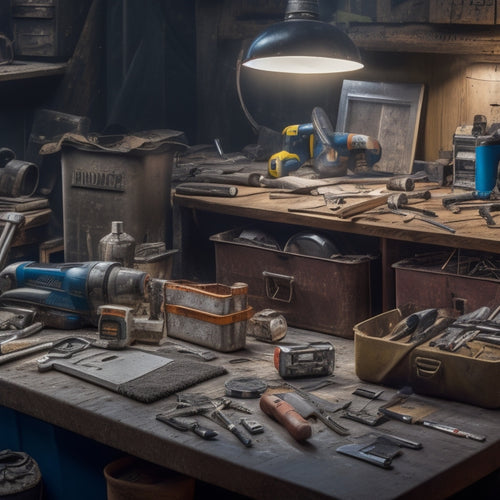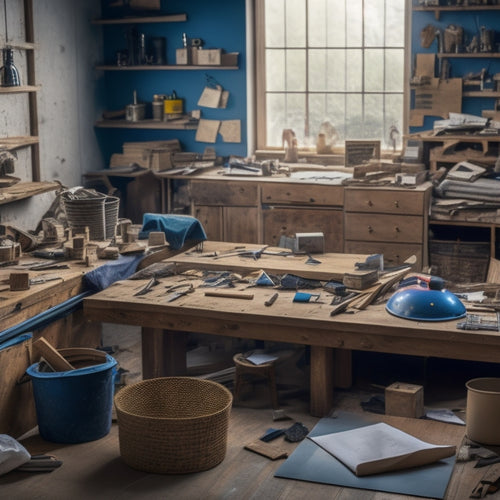
Vibration Tool Safety Checklist for Home Renovation
Share
When using vibration tools for home renovation, you must take a proactive approach to safety. Start by developing a thorough safety plan that identifies potential hazards, conducts a site assessment, and outlines emergency procedures. Familiarize yourself with the tool's operation manual and wear personal protective equipment (PPE) like gloves and safety glasses. Regularly inspect and maintain your tools and PPE to prevent mechanical failures and guarantee effectiveness. Be aware of hazardous materials on site and follow safety protocols for handling and disposal. By following these essential safety measures, you'll be well-prepared to tackle your project - and what you're about to learn will give you even greater peace of mind.
Key Takeaways
• Develop a thorough safety plan identifying potential hazards, including uneven flooring and exposed wiring, before starting renovation work.
• Familiarize yourself with vibration tool operation manuals and conduct regular maintenance to prevent mechanical failures.
• Wear appropriate personal protective equipment (PPE) such as gloves, safety glasses, and dust masks to mitigate risks associated with vibration tools.
• Identify and handle hazardous materials like asbestos and lead-based paint according to safety protocols and local guidelines.
• Establish clear emergency response procedures, including first aid protocols and evacuation routes, in case of accidents or equipment failures.
Pre-Renovation Safety Planning
Before operating vibration tools, you must develop a thorough pre-renovation safety plan that identifies potential hazards and outlines measures to mitigate them. This plan should include an extensive site assessment to identify potential hazards, such as uneven flooring, exposed wiring, or structural weaknesses.
A risk evaluation is also essential to determine the likelihood and potential impact of these hazards. By doing so, you'll be able to prioritize and address the most critical risks first.
Your pre-renovation safety plan should also consider the specific vibration tools you'll be using, as well as the materials and surfaces you'll be working with. This will help you anticipate potential hazards associated with tool operation, such as vibration-induced damage to surrounding structures or nearby objects.
Additionally, the plan should outline emergency procedures, such as first aid protocols and evacuation routes, in case of an accident. By investing time and effort into pre-renovation safety planning, you'll be better equipped to minimize risks and guarantee a safe working environment for yourself and others.
Operating Vibration Tools Safely
With an extensive pre-renovation safety plan in place, you can now focus on operating vibration tools safely and effectively by following established guidelines and protocols.
First, make sure you're familiar with the tool's operation manual and understand the recommended usage guidelines. Conduct regular tool maintenance to prevent mechanical failures that can lead to accidents. Check for worn or damaged parts, and replace them promptly.
Additionally, always wear personal protective equipment (PPE) such as gloves, safety glasses, and a dust mask to minimize vibration exposure.
When operating vibration tools, maintain a firm grip and keep your body balanced to avoid losing control. Take regular breaks to rest your hands and arms, as prolonged vibration exposure can cause fatigue and discomfort.
It's also crucial to work in a well-ventilated area to prevent inhalation of dust and debris.
Hazardous Material Handling
When handling hazardous materials, you must meticulously follow safety protocols to prevent exposure and environmental contamination.
As a homeowner, it's essential to identify hazardous materials on your renovation site, such as asbestos, lead-based paint, or chemicals. Proper hazardous material identification is key to ensuring your safety and the safety of those around you. Always read labels carefully, and research the materials you're working with to understand their risks and handling requirements.
When it comes to disposal, you must adopt safe disposal practices to prevent environmental harm. Check with local authorities for guidelines on disposing of hazardous materials, and never mix them with regular trash. You may need to separate materials, label them properly, and take them to designated facilities for disposal.
Personal Protective Equipment
You must always wear appropriate personal protective equipment (PPE) to prevent injuries and exposure to hazardous materials during vibration tool operation. As a responsible DIY enthusiast, it's essential to prioritize your safety and well-being.
PPE selection is critical, and you must choose equipment that meets the specific hazards associated with vibration tools. Here are three important PPE items to include in your safety arsenal:
-
Safety glasses or goggles: Protect your eyes from flying debris, dust, and other particles.
-
Dust mask or respirator: Prevent inhalation of hazardous materials, such as dust, chemicals, or other airborne contaminants.
-
Gloves and safety footwear: Shield your hands and feet from cuts, abrasions, and other injuries.
Regular equipment maintenance is also important to guarantee your PPE remains effective. Inspect your equipment regularly, clean and replace worn-out parts, and store them properly when not in use.
Emergency Response Procedures
Developing a clear emergency response plan is essential to minimizing risks and guaranteeing prompt action in the event of an accident or equipment failure while operating vibration tools. You need to be prepared for any situation that may arise, and having a plan in place will help you respond quickly and effectively.
To create an effective emergency response plan, you should identify potential hazards, designate emergency contacts, and establish a first aid protocol. Here's a sample emergency response plan:
| Emergency Situation | Response Action | Contact Information |
|---|---|---|
| Medical Emergency | Call 911 or local emergency number | Emergency contact list |
| Equipment Failure | Shut off power, isolate area | Manufacturer's customer support |
| Fire | Evacuate area, call fire department | Fire department's phone number |
Remember to review and update your emergency response plan regularly to guarantee it remains relevant and effective. Make sure all team members are familiar with the plan and their roles in responding to emergencies. By being prepared, you can minimize risks and guarantee a safe working environment when operating vibration tools.
Frequently Asked Questions
How Often Should I Maintain and Clean My Vibration Tools?
You should prioritize tool maintenance by cleaning your vibration tools regularly to guarantee peak performance and prevent damage.
Aim to clean them after every use, and perform a deeper clean every week or two, depending on usage.
Vibration cleaning is essential to remove dust and debris that can affect tool accuracy and longevity.
Are There Any Age Restrictions for Operating Vibration Tools?
As you step into the world of DIY, it's important to know that age isn't just a number when it comes to operating vibration tools - it's a significant factor in ensuring safety.
You'll find age regulations vary by region, but generally, operators must be at least 18 years old.
Don't assume you're exempt from operator training just because you're of age; proper education is essential to handling these powerful tools safely and effectively.
Can I Use Vibration Tools on Uneven or Slippery Surfaces?
When working with vibration tools, you'll want to guarantee you're on stable ground - literally.
Avoid using them on uneven or slippery surfaces, as they can compromise your vibration stability. You need surface traction to maintain control and prevent accidents.
If the surface is wet, oily, or irregular, it's best to find a safer alternative. You can't afford to take risks with your safety, so always prioritize a firm footing.
What Are the Consequences of Prolonged Vibration Exposure?
You're right to wonder about the consequences of prolonged vibration exposure.
When you're repeatedly exposed to vibrations, you're at risk of developing serious health risks.
Prolonged vibration exposure can lead to Hand-Arm Vibration Syndrome (HAVS), causing numbness, tingling, and weakened grip strength.
It can also trigger musculoskeletal disorders, affecting your wrists, elbows, and shoulders.
Can I Modify or Alter Vibration Tools for Personal Use?
When modifying vibration tools for personal use, you're taking a risk. Altering tools can compromise their safety features, leaving you exposed to hazards.
Before making any changes, you must guarantee they comply with safety regulations. Failure to do so can result in serious injuries or even fatalities.
It's essential you understand the implications of tool modifications and prioritize your safety above all else.
Don't compromise your well-being; always follow established guidelines and consult with experts if necessary.
Conclusion
You've made it to the end of this vibration tool safety checklist, and we're betting you're itching to get back to your home renovation project.
Ironically, the most dangerous part of the job is probably behind you - not using these safety measures.
Don't become a statistic: one wrong move with a vibration tool can lead to severe injury or even death.
Stay vigilant, and remember, safety isn't just a checklist, it's a state of mind.
Related Posts
-

Smart Guide to Buying Second-Hand Renovation Tools
When buying second-hand renovation tools, you'll want to set clear renovation goals and a realistic budget to priorit...
-

7 Best Home Renovation Project Checklists With Timelines
You're about to initiate a home renovation project, and establishing a clear plan with timelines is vital to staying ...
-

Stucco Tool Kit Checklist for Home Renovation
You'll need a thorough stucco tool kit to guarantee a successful home renovation, as the right tools can make all the...


